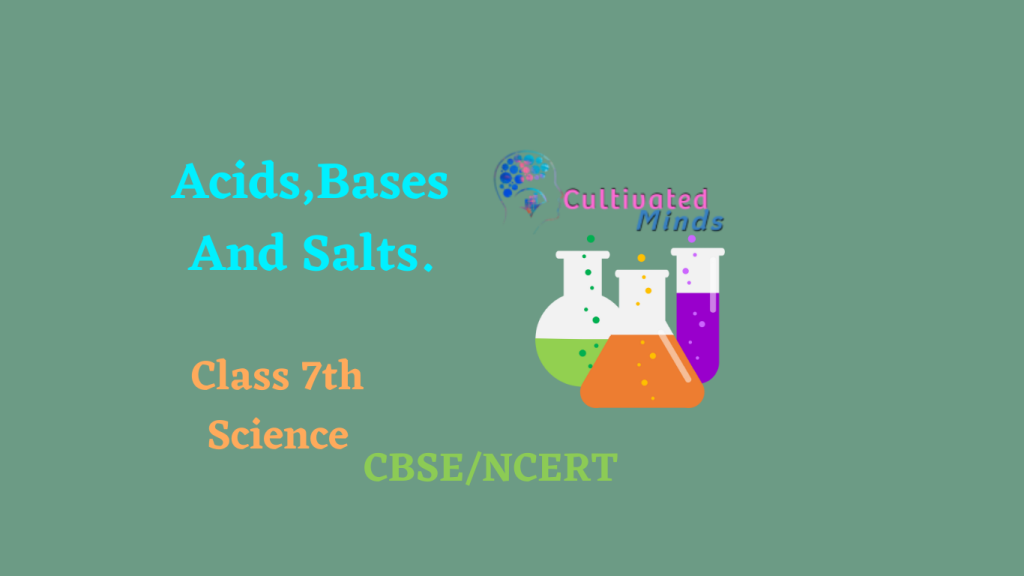Q 1.
1. State differences between acids and bases.
Answer: The substances that has sour taste are called acids and the substances that are bitter in taste are called bases.
2. Ammonium is found in many household products, such as window cleaners. It turns red litmus blue. What is its nature.
Answer: The substances that turn into red litmus blue are base. Therefore ammonium is basic in nature.
3. Name the source from which litmus solution is obtained. What is the use of this solution
Answer: Litmus solution is extracted from lichens and is used to test the acidic or basic nature of the solution.
4. Is the distilled water acidic/basic/neutral? How would you verify it
Answer: Distilled water is neutral in nature. We can verify it by using litmus paper. When some drops of the distilled water are poured on redor blue litmus paper its colour remains same.
5. Describe the process of neutralization with the help of an example.
Answer: Neutralization is a reaction between acids and bases. Acids and bases are opposites in nature when they mix they neutralize the effects of each other. The substance formed in the neutralization reaction are known as salts.
HCl + NaOH —->NaCl + H2O
6. Mark Trur if the statement is true and False if it is false.
(i) Nitric acid turns blue litmus red.
Answer: True
(ii) Sodium hydroxide turns blue litmus red.
Answer: False
(iii) Sodium hydroxide and hydrochloric acid neutralize each other and form salts and water.
Answer: True
(iv) An Indicator is a substance that shows different colors in acidic and basic solutions.
Answer: True
(v) Tooth decay is caused by the presence of a base.
Answer: False
7. Dorji has a few bottles of soft drinks in his restaurant, but unfortunately, these are not labeled. He has to serve the drinks on the demand of customers. One customer wants an acidic drink; another wants a basic and the third one wants a neutral drink. How will Dorji decide which drink is to be served to whom?
Answer: Dorji can use the indicator like litmus which can help him take the decision. If a few drops of a drink change blue litmus to red then it is acidic in nature and if it turns red litmus to blue then it is basic in nature.
8. Explain why:
(a) An antacid tablet is taken when you suffer from acidity.
Answer: An antacid tablet is taken when you suffer from acidity because the antacid tablet is basic in nature; it reacts with the excess acid in our stomach causing a neutralization reaction. Hence, it relieves us against disease.
(b) Calamine solution is applied to the skin when an ant bites.
Ans: Calamine solution is applied on the skin when ant bites.Because ant bites inject acid in the skin and calamine solution is basic in nature it reacts with the acid causing a neutralization reaction. So,it relieves us from irritation.
(c) Factory waste is neutralized before disposing it into the water bodies.
Answer: Factory waste is neutralized before disposing it into the water bodies because excess acids or bases can be dangerous for the organisms living in the water.
9. Three liquids are given to you. One is hydrochloric acid, another is sodium hydroxide and the third is a sugar solution. How will you identify them? You have only a turmeric indicator.
Answer: Turmeric is acidic in nature and so it will turn red in contact with a base. From this we can figure out that sodium hydroxide is a base.
Now we are left with sugar solution and hydrochloric acid. The red spot created on the litmus due to the base will again turn yellow while in contact with an acid. You will observe that the hydrochloric acid will turn the red spot into yellow again and Hence it is an acid.
Sugar solution will not affect the litmus and hence it is a neutral solution.
10. Blue litmus paper is dipped in a solution. It remains blue. What is the nature of the solution? Explain.
Answer: We know that acids turn blue litmus into the red. When a blue litmus paper is dipped in a solution and it remains blue then the solution cannot be acidic.
Hence the solution can either be basic or neutral.
11. Consider the following statements:
(a) Both acids and bases change color at all indicators.
(b) If an indicator gives a color change with an acid, it does not give a change with a base.
(c) If an indicator changes color with a base, it does not change color with an acid.
(d) The change of color in an acid and a base depends on the type of indicator.
Which of these statements are correct?
(i) All four
(ii) A and B
(iii) B and C
(iv) only D

